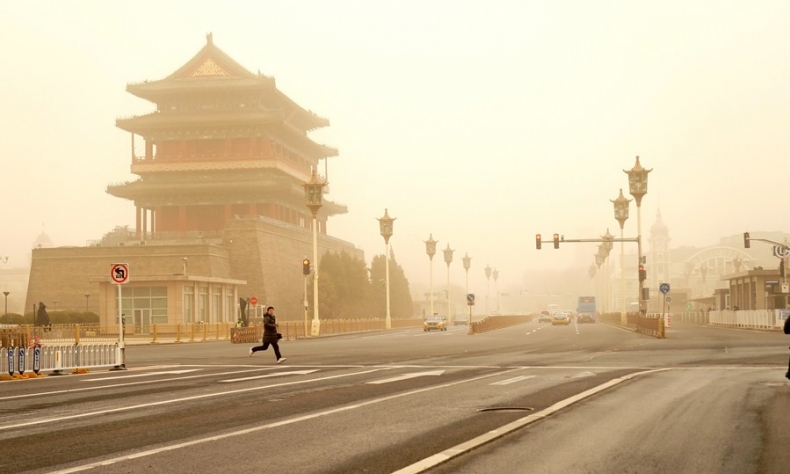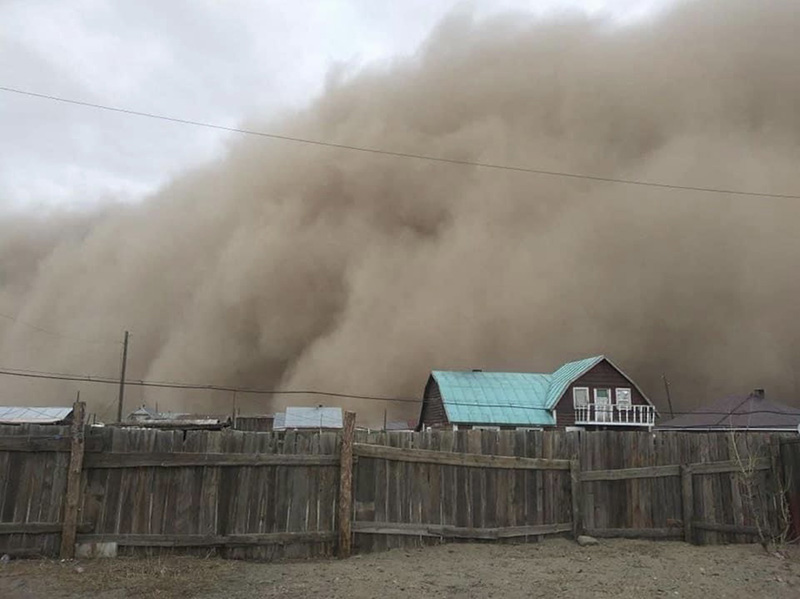Sandstorms a Strong Reminder That Extreme Weather Won’t Just Blow Away

The recent sandstorms to hit northern China are the latest example of extreme weather in 2021, after events in the United States and Europe, and are a spectacular reminder of the damage that can be caused when global temperatures and emissions continue to remain unchecked.
For those waking up in China’s northern provinces on March 15, many would have been forgiven for thinking they’d been transported to a completely different planet, as their cities were engulfed in thick orange smog the likes of which had not seen for a decade.
Brought on by severe sandstorms from neighbouring Mongolia, according to China’s National Meteorological Centre, the epic storms brought traffic, flights and even schools to a close as people tried to deal with the hazardous conditions. In downtown Beijing, the average concentration of dangerous airborne PM10 particles topped 8118 micrograms per cubic meters – nearly seventeen times the recommended exposure limit – while levels of PM2.5 rose to 600 micrograms in many parts of the city, reaching a 24-hour average of 200 before midday.
The freakish storm, which many commented had turned parts of the country into a scene from dystopian movie Blade Runner, covered an area of more than 466,000 square miles – nearly an 8th of China’s entire land mass – and continued to cause problems in many parts of northern China well into Thursday evening.
Extreme weather rises globally
As the dust finally settles – quite literally in some cities – the inquest into why the storms were so severe and long lasting has already begun.
Zhou Bing, chief expert at the China Meteorological Administration’s National Climate Centre, claims strong winds and a dry winter contributed to the sandstorm’s severity. But like most recent instances of extreme weather, Zhou noted “rising temperatures” as playing a key role in the storm’s brutalness.
It follows a pattern of rising extreme weather events which scientists say are occurring “more frequent and severe” than ever before. 2021 may only be three months in, but already instances of extreme weather have occurred in the United States, Europe, and now China, following a 2020 where forest fires, floods and harsh droughts occurred with frightening regularity.
Fundamental to this increase, according to the World Meteorological Organization, has been the significant increase in global temperatures, with 2020 confirmed as the second warmest on record by American scientific agency the National Oceanic and Atmospheric Administration. Seven of the world’s warmest years have now occurred since 2014, according to the agency, with last year’s coming despite the world’s industrial output falling to record lows due to the coronavirus pandemic.
The damage caused by these bouts of extreme weather have, as the World Meteorological Organization stated in its latest annual report, become more severe, accounting for high death tolls and economic damage. Floods along the Yangtze river in China last year caused 279 deaths and US15 billion in economic losses, while droughts in Brazil were responsible for agricultural losses of almost US$3 billion. Australia’s bushfires, some of the largest in its history, decimated an area of 20 million acres, accounting for 25 deaths and half a billion animal fatalities.

Green-effect in China
Given the strong causal link between rising temperatures and extreme weather events, scientists have demanded governments worldwide make an immediate and concerted effort to reduce their carbon emissions, encouraging them to set strict targets to ensure they do so.
In this respect China has taken on greater responsibility to ensure it lowers its emissions, announcing last year to become carbon neutral by 2060, a move which climate-change watcher Climate Action Tracker believes could lower global warming projections by around 0.2 to 0.3°C – the biggest single reduction ever estimated by the scientific organisation.
To do this, authorities have already initiated a radical overhaul in key areas, including how the country produces energy. Years of investment have turned China into a leader in renewable energy technologies, including solar panels and wind turbines. China’s renewable energy capacity now makes up nearly 30 percent of the world’s total, while the country plans to increase its share of non-fossil fuel energy to 25 percent by 2030.
The government has also become tougher on businesses and enterprises that do not comply with its environmental targets, initiating fines and even prison sentences if necessary. In Tangshan, Hebei province, located 190 kilometers to the east of Beijing, the leaders of at least four steel and iron enterprises were detained for a minimum of 15-days and fined for fabricating and deleting information on production records after failing to reduce their pollutant discharge as instructed on polluted days.
Consumers thinking greener
Changing energy alone however will not bring temperatures down sufficiently to ensure extreme weather becomes less severe.
Scientists continue to warn that people must also live radically differently from before if emission targets are to be met. This includes transportation, one of the biggest emitters of greenhouse gasses, accounting for one-fifth of all global CO2 emissions, and a sector that Chinese authorities have highlighted where emissions must be reduced “as soon as possible”.
Cutting the emissions caused by personal vehicle usage, which accounted for 48 percent of China’s transport emissions last year, is essential to achieving this, and while promoting the use of public transport has been used, encouraging consumers to switch to New Electric Vehicles (NEV) has proved more effective.
China’s NEV market now accounts for nearly 50 percent of all NEW’s sold in the world, selling 1.3 million units last year, up from 1.1 million in 2019. This is expected to grow to 1.8 million sales this year, with the Chinese government hopeful NEV’s will make up 20 percent of all auto sales by 2025.
As well as transport, more and more Chinese consumers are embracing greener habits, whether reducing their meat intake, shopping locally or sorting their rubbish. Private companies have sprung up offering organic or green services, such as Ai fenlei, which offers to collect, sort and then send rubbish to recycling companies in the Beijing area.
Change must come quicker
Globally, there is still however a lot of work to be done. While 2020 emissions were their lowest in years due to the coronavirus, levels of greenhouse gasses are already climbing back to pre-pandemic levels.
Coal power, regarded as the most destructive fossil fuel for the environment, is expected rebound this year, with countries such as China, the UK and the US exploring plans to open more coal mines as prices for natural gas increase, and the need to get state economies moving again becomes more urgent.
Despite many state economies continuing to be closed, this most recent winter – December 2020 to February 2021 – was the eighth warmest since records began, and the 45th consecutive year that winter temperatures were above average, making the chance of more extreme weather over the year a distinct and dangerous possibility.
The recent sandstorms may not have been the most destructive extreme weather event to hit this year, but they are spectacular example of what happens when rises in global temperatures and emissions remain unchecked. And while some in northern China were able to see the funny side of a musky orange morning, just as some Europeans enjoyed the unusual dumping of snow that hit their streets, the long-term implications of extreme weather are only going to cause more problems, bring greater economic hardships and ultimately, more deaths.
The world’s environmental situation, like much of Beijing last week, is therefore currently flashing a dark and ominous amber. Failure to heed its warning by reducing emissions and controlling temperatures could see that warning quickly turn to a deadly red, pushing the planet even further to the point of no return.
 Facebook
Facebook
 Twitter
Twitter
 Linkedin
Linkedin
 Google +
Google +







